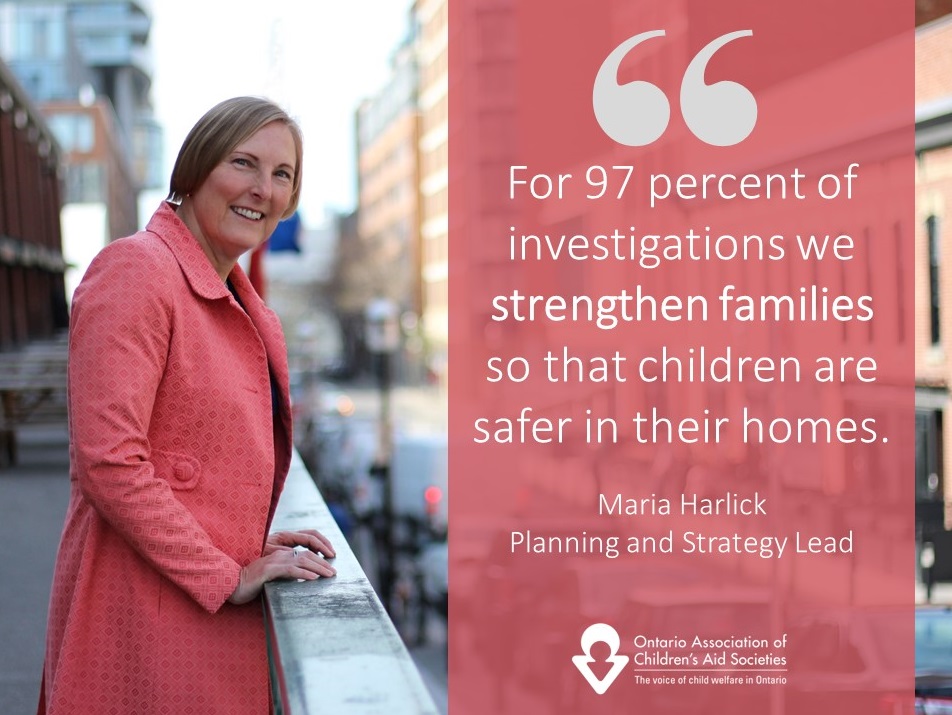Maria Harlick, Planning and Strategy Lead at OACAS, discusses its latest findings.

What stood out for you in the latest release of the study?
The significant role that chronic needs plays in bringing families into contact with the child welfare system stood out for me. Over half of maltreatment related investigations (53%) in Ontario in 2013 involved a primary caregiver living in socioeconomic hardship. This finding reveals that it’s not urgent protection cases such as physical abuse that are primarily endangering children and youth in Ontario but ongoing chronic needs generated by poverty, mental health, and substance abuse. I should note that our Child Welfare Performance Indicator findings have also reached the same conclusions about the connection between chronic needs and child maltreatment.
What are the implications of these findings for how we address child abuse and neglect in Ontario?
The fact that chronic, systemic issues are impacting a family’s ability to support and ensure the safety and well-being of their children has important implications for how child welfare supports children and families. The types of interventions for these families need to include strategies to help address their situation whether it be a housing issue, lack of employment, and so on. Child protection workers need to work closely with other parts of the system that have the expertise to address these larger issues. As a result these findings have important implications for the broader social services system and our governments. The number one chronic issue is poverty, and this is a systemic issue that child welfare cannot solve on its own.
Are there any other statistics in the study that suggest a need for change?
A recent analysis of the data collected about race and poverty shows that Indigenous children and African-Canadian children are much more likely to be investigated, transferred to ongoing child welfare services, and placed in out-of-home care than White children. The numbers are especially high for Indigenous children. Our next step is to break these numbers down by age, gender, race, ethnicity, religion, citizenship, place of origin, and sexual orientation so that we can get a better understanding of the children, youth and families Children’s Aid Societies are serving. The Ontario government through the Anti-Racism Directorate is developing an Identity-based Data Collection Standard and User Guide / Training to describe how this sensitive data is to be collected. This Standard will be based on the Ontario Human Right Code grounds and be applied to all Ministries in the Ontario Government.
Any other findings that you think should be highlighted about child abuse and neglect in Ontario?
The data tell us that youth in the 12–15 age group represent 23% of investigations into child maltreatment. That’s a substantial number. It’s makes me wonder about the 16–18 age group which until recently has not been granted protection under Ontario legislation. The new Child, Youth, and Family Services Act that was just passed in the legislature changes that. I think we will learn some disturbing truths about chronic needs including poverty and mental health in this age group.
The Ontario Incidence Study also collects information about calls and referrals that Ontarians make to Children’s Aid when they are concerned about the safety of a child. Are there any interesting results in this category?
While professionals like teachers and the police account for most of our referrals, daycare providers rarely call Children’s Aid with a concern about a child.
Why is the referral rate so low?
Day care providers take care of the most vulnerable children, those under the age of 5, who cannot always speak for themselves, so it’s an area we need to explore further.
This cycle of the Ontario Incidence Study shows that in 97% of investigations, children remain in the home. Is that a surprising number?
It’s a number that might be surprising to many people who tend to think the only role of Children’s Aid is to take children into care. But for 97% of investigations, we help strengthen families so that children can be safer in their homes. In only 3% of the investigations that we conduct are children taken from their homes and placed in foster care or other forms of care, like living with extended family.
Can you give me an example of the kind of services that Children’s Aid provides to strengthen families?
A child protection worker will visit a family at home and develop a service plan with the family’s input. The plan identifies strengths as well as areas to improve. Often a family will have a combination of weaknesses that cause them to struggle.
For instance, let’s say a family is connected to a community group. That’s a strength, in that they have a social network. But this family might also live in poverty, and have trouble budgeting their money. Their worker will connect the family to the resources they need to overcome their challenges. Mom or Dad might need substance abuse counselling. Or their child might need a homework tutor, and that’s where the tension is. A child protection worker works with a family for 22 months on average to resolve the situation that led to the protection concerns in the first place.
The 2013 Ontario Incidence Study on Reported Child Abuse and Neglect, led by principal investigator Dr. Barbara Fallon, is based on 5,265 child maltreatment investigations done in the fall of 2013 and tracked at 17 child welfare agencies in Ontario.
The study follows an investigation from the time an intake worker receives a call of concern about the safety of a child to the time the investigation is completed.
The results help the child welfare sector understand how to better serve children and families by looking at systemic issues underlying child abuse and neglect, such as poverty, addiction, and intimate partner violence.